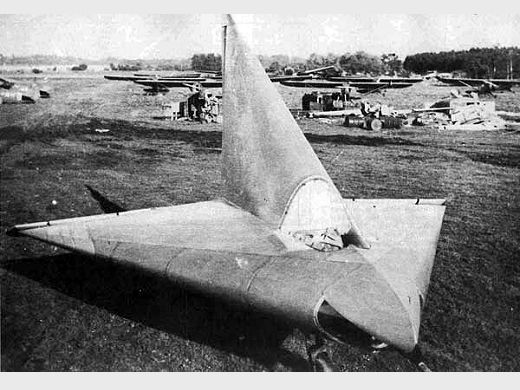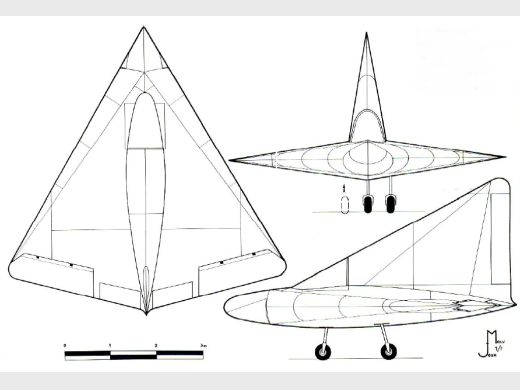
Akaflieg Darmstadt-München DM-1
Autre nom (ou nom en langue originelle) : Akaflieg Darmstadt D-33| DONNÉES GÉNÉRALES |
| Année du premier vol (ou de design, si seul projet) |
1944 |
| Pays | Allemagne |
| Designer(s) | LIPPISCH, Alexander |
| Premier constructeur | Akaflieg München |
| Type d'appareil | Planeur |
| Fonction | Expérimental |
| SPÉCIFICATIONS TECHNIQUES |
| Envergure | 6 m |
| Longueur | 6.32 m |
| Hauteur | 3.25 m |
| Allongement | -- |
| Surface alaire | -- |
| Profil aile | -- |
| Masse à vide | 375 kg |
| Masse maxi | 560 kg |
| Charge alaire | -- |
| Vitesse mini | 72 km/h |
| Vitesse maxi | 560 km/h |
| Finesse maxi | 7 |
| Taux de chute mini | -- |
| Nb sièges | 1 |
| Structure | Tubes acier soudés, revêtement en contreplaqué imprégné de bakélite. |
AUTRES INFORMATIONS
| Constructeur(s) |
| ||||||
| Infos techniques | The DM1 was built as a single-seat glider built from steel-tubing plywood and bakelite impregnated plywood, with a cockpit in the extreme nose of the junction of the triangular mainplanes and fin. | ||||||
| Histoire résumée | À la fin de 1944, le spécialiste allemand reconnu dans le domaine de l'ingénierie aéronautique Alexander Lippisch a commencé à construire un avion de chasse intercepteur, sur un schéma très inhabituel. Le Projet LP-13A est une "aile volante" avec un moteur à réaction dans la queue et le train d'atterrissage tricycle avec une roue de nez. La flèche de l'aile de 60 degrés, laissait prévoir une vitesse maximale d'environ 2,6 Mach. Pour tester ces solutions, un modèle non motorisé a été construit durant l'automne 1944 : d'est le DM-1. En principe, il ne diffère pas de l'intercepteur prévu, sauf que le moteur n'a pas été installé et que la structure a été allégée. De plus le nez du fuselage avait un fond vitré. Les essais au sol ayant été concluants, il a été planifié de tester le DM-1 en vol, en utilisant comme avion porteur un Siebel Si-204, dont la cellule a été aménagée pour fixer le DM-1 sur son "dos". Mais la défaite de l'Allemagne a interrompu ces essais, et ce sont les américains qui ramenèrent le prototype aux Etats-Unis. Jusqu'en février 1946 ils réalisèrent un cycle complet de tests en utilisant l'avion de transport C-47 de remorquage. Plus tard, les données obtenues lors des tests du DM-1 ont été très utile pour le développement de leur chasseur à réaction XF-92. The DM-series was a joint project of the Darmstadt and Munich Akafliegs. During planning all limits were set aside and, what may seem impossible today was seriously studied, such as the DM4 with a planned wing area of 70m2 (753.5 sq.ft.)expected to reach speeds of 16000 km/h (10,000 mph ). During World War II Dr. Alexander Lippisch proposed a ramjet propelled point defence fighter;Projekt P.13a. To investigate the low speed handling and aerodynamics of this delta-winged fighter Lippisch arranged for Akaflieg Darmstadt to build a full-scale flying glider model, which emerged as the Darmstadt D-33. After the Akaflieg Darmstadt workshop was bombed in September 1944 the D-33 project was moved to the Akaflieg München workshops at Prien am Chiemsee. At Prien Wolfgang Heinemann and Hans Zacher from Darmstadt, with Klaus Metzner and Hermann Nenninger from Munich completed the D-33 as the Akaflieg Darmstadt/Akaflieg München DM1. After May 1945, work continued at the DM1 on behalf of the U.S. military government, with General Patton and Charles Lindbergh visiting Prien to see the project. Completed in early November 1945, the DM1 was shipped in a wooden box to Langley Field in Virginia where the flow behavior of the DM1 was examined in the NACA (National Advisory Committee for Aeronautics, forerunner of today's NASA) full-size wind tunnel. The Delta-glider ultimately served as inspiration for the Convair delta fighters such as XP-92, XF-92A, XFY, F2Y, F-102 and F-106. After completion of testing the DM1 was retired to the National Air and Space Museum, Smithsonian Institution in Washington, D.C. for storage at the Paul E. Garber Preservation, Restoration, and Storage Facility. | ||||||
| Liens personnalités | Pas de personnalité associée. | ||||||
| Compléments docs |
SOURCES DOCUMENTAIRES
| Liens WEB | Site : Wikipedia (en) . Texte + photo + specs. (2011-06-10 CL) Site : Akaflieg München . Texte + specs. Page en anglais. (2011-06-10 CL) Site : Luft 46 . Note + 3 photos. (2011-06-10 CL) Site : Coin de Ciel [Уголок неба] . Texte + 4 photos + plan 3 vues + specs. (2011-08-10 CL) Site : 100 Jahre Nurflügel /A century of flying wings . Note + photos + plan 2 vues. (2011-08-10 CL) Site : Akaflieg München e.V. . Texte + specs. (2012-05-12 CL) Site : Luft Archiv . 5 photos. (2014-10-12 CL) |
| Livres | Forschen-Bauen-Fliegen par LEMKE, Frank-Dieter & JACOB, Rolf (2010) [p. 9. Mention]. |
| Autres sources | 50 ans avant Hermès, le planeur supersonique, par Jean Molveau, Vol à Voile Magazine n° 26, mai-juin 1988. |

Team J2mcL © 2003 -
- Pages optimisées pour Mozilla Firefox

